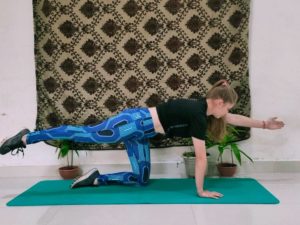After my c-section, I was terrified to do any abdominal exercises and avoided them altogether for nearly a year. I knew my core was severely damaged both from pregnancy and surgery, so I gave myself plenty of time to rest and recover. After I felt assured my abdomen wouldn’t suddenly tear open, I began doing gentle yoga. Despite working diligently, I couldn’t feel my pelvic floor at all, something I had always done easily even during pregnancy.
In hopes of strengthening my core, I started doing basic abdominal exercises. Later, while attempting to do crunches, I noticed my abdomen forming a cone shape. I read about diastis recti and checked myself. Sure enough, I had a two finger wide separation between my abdominal muscles above and behind my belly button. No wonder I couldn’t find my pelvic floor during yoga practice!
What is Diastis Recti?
Diastis recti is a separation in the middle of the abdominal muscles. This separation can be large or small. Severe diastis recti may require surgery, which sutures the muscles back together. Diastis recti is typically caused by pregnancy, since hormones cause softening of the abdominal muscles to accommodate a growing fetus. For many women, diastis recti can heal on its own, without intervention. However, a study by the British Journal of Sports Medicine found 32.6% of women studied had abdominis recti 12 months post-partum. Barring pregnancy, diastis recti can occur due to genetics, age, weight fluctuations, or undue stress on your abdominal wall.
Women, men, and newborns can be affected by diastis recti, thus causing the stomach to appear bloated, hanging, or even sunken in the middle of your abs. Not only can diastis recti affect your appearance, but it can cause issues like back pain, constipation, bad posture, hernias, pelvic floor dysfunction, and incontinence. Certain exercises like crunches can actually make diastis recti worse and impede healing.
Fortunately I didn’t do any permanent damage from my erroneous exercises. Over time, with proper exercises I healed from a two finger separation in the center of my abs to a “normal” half finger separation.
How to check yourself for diastis recti:
- Lay on your back with your feet on the floor. Keep your feet hip’s width apart but your knees together.
- Slowly raise your shoulders and head off the ground (you can support your head with one hand if needed).
- Contract your abdominal muscles and place your fingertips above your belly button. Then, use your fingertips to feel for separation between your abdominal muscles above and below your belly button. Diastis recti can be measured by width and depth. One to two finger separation is considered “moderate”. Three or more fingers is considered severe and should be evaluated by a physician.
Avoid these exercises:
- Crunches
- Push ups
- Planks
- Abdominal stretches like upward dog, sphinx pose, cow pose, or cobra pose
- Backbends
- Any twisting motions like bicycle crunches or Russian twists
- Jackknifes
- Roll ups
- Any movements that cause “doming” of the abdomen or pushes your abdominal muscles outwards
Healing Exercises:
Deep breathing, using your diaphragm. Start in a comfortable seated position, with your back straight. Try to find your pelvic floor muscles and engage them. Your pelvic floor muscles are the ones used to start or stop urine flow. Tighten your pelvic floor muscles and feel them lifting up into your belly. This is the “easiest” beginner exercise, and should be practiced regularly. Knowing how to properly activate your pelvic floor can prevent further injury while doing other abdominal exercises.
Bridge pose- Firstly, lay flat on your back with your legs bent at an angle. Make sure your legs are directly in line with your hips. Then, place your hands on either side of your body with your palms on the ground. Lift your bum and lower back off the ground while squeezing your glutes. Tighten your abs and pull your stomach in towards your spine.

Modified side plank- Start by laying on your side. Place your forearm on the ground and support your body with your bottom knee. Keep your top leg outstretched. Then, lift your hips into the air, maintaining a straight line with your body. When you get stronger, you can add hip dips and eventually work your way up to regular side plank with dips.


Heel slides- Begin by laying flat on your back, with your legs bent. Outstretch one leg at a time, sliding your heel across the floor until your leg is straight. After your leg has straightened, slide your leg back into the original bent position and repeat on the other side. Always keep your lower back pressed firmly into the ground.


Wall squat- With your back supported against the wall, squat down as far as comfortably possible and hold. Press your lower back into the wall and engage your abs. Focus on squeezing your abs into your spine while engaging your pelvic floor.

Bird dog- Begin on all fours in a tabletop position. Ensure your arms are directly under your shoulders and your knees are below your hips. Outstretch your right arm and your left leg at the same time. Repeat using the opposite arm and leg. Keep your spine straight.

Heel taps (also called “penguins”)- Start by laying flat on your back with your legs bent. Slightly raise your shoulders and head and stretch your arms out with palms up, so they are pointed towards your feet. Bend to the left and tap your left heel with your left hand. Repeat on the other side. Keep your lower back firmly pressed against the ground, which will protect your abs.

Warrior 3- Starting in a forward fold with your hands on the ground or a yoga block, slowly raise one leg until it is horizontal with the floor. You can continue to use the floor or yoga block for support if you need it. When you feel like you can balance, then slowly raise your arms either to your chest with hands in prayer, or behind you, forming a T shape with your body.

Remember to take things slowly and support your abdominal muscles by maintaining good posture throughout your day. If you feel any pain during exercise, stop. Avoid heavy lifting or any exercises that cause your abdominal muscles to “cone” outwards. Should you feel like you need additional help, please see a doctor or physical therapist. It is hard work healing diastis recti, but over time your body will thank you for your dedication!
Get more like this—Sign up for our daily inspirational newsletter for exclusive content!
___
Photo: Jessi Ferguson




